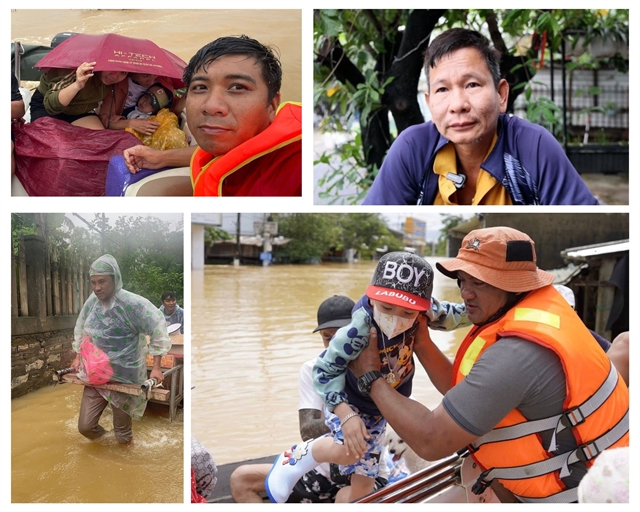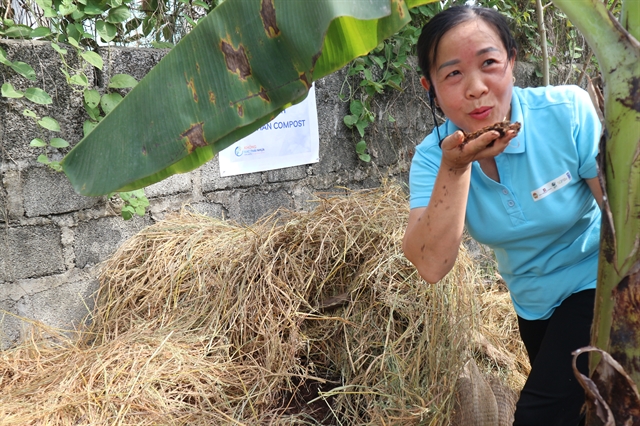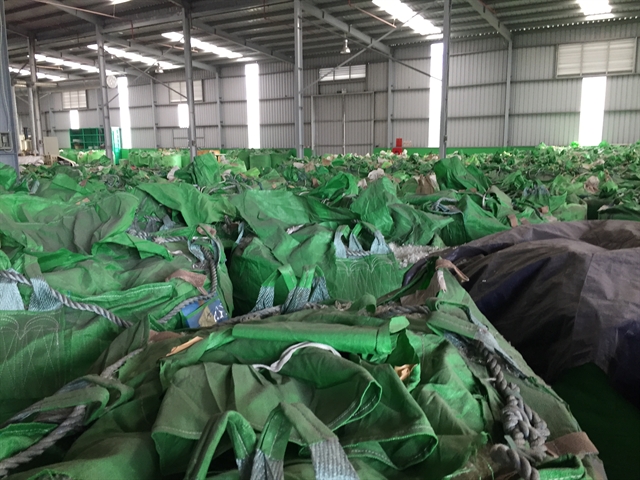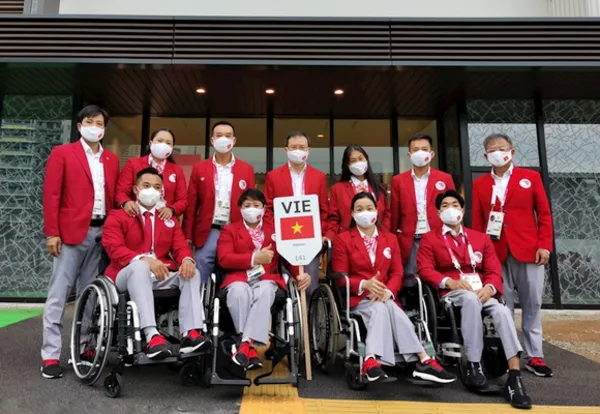 Environment
Environment

A project aims to help local people earn by thoroughly sorting and treating waste.

|
| Đinh Thị Luyến shows other farmers compost she makes from leftover food and probiotics. — VNS Photo Khoa Thư |
Khoa Thư
QUẢNG NINH — Once a bag of garbage is thrown away, what actually happens to it is a mystery to many.
Whether it ends up in a landfill or drifts out to sea, to manage waste is to know how it is generated, according to researcher Chu Mạnh Trinh.
Tracing the journey of waste, the researcher, who has studied and worked on waste management for nearly 20 years, in early June led a group of some 30 farmers, scrap collectors and public servants from Đà Nẵng, Bình Định, Bình Thuận and Bình Dương to Area 8 fishery village in Hạ Long City’s Hà Phong District, Quảng Ninh Province.
The village is inhabited by people from five smaller villages scattered on Hạ Long Bay who were persuaded to move to Hà Phong in 2014 by local authorities to ensure their children enjoy a good education and to conserve the bay's ecosystem.
Up to 380 fishing boats dock at the village’s pier twice a month, bringing ashore garbage produced after 14-day trips.
Leftover food is dumped in the water while tin cans, plastic bags and bottles are brought back as the fine for dumping them in Hạ Long Bay is too high for fishermen to pay.
Making money from waste is a new approach introduced by Trinh under the framework of 'Scaling Up a Socialised Model of Domestic Waste and Plastic Management in 5 Cities' (DWP5C) – a project implemented in Quảng Ninh, Đà Nẵng, Bình Định, Bình Thuận and Bình Dương provinces by UNDP Việt Nam, the Norwegian Ministry of Foreign Affairs and Việt Nam Administration of Seas and Islands.
The project aims to help local people earn by thoroughly sorting and treating waste.
“Waste is not something to dispose of if we look closely into its lifespan,” said Trinh. “This approach offers chances to use waste as a resource and turn it to profits.”

|
| Area 8 fishery village. Up to 380 boats return to the village twice a month, bringing ashore waste generated during a 14-day fishing trip. — VNS Photo Khoa Thư |
Inspired after joining a waste sorting workshop by Việt Nam Women’s Union, for two years, Đinh Thị Luyến in Hà Phong District has practised composting at home.
Organic waste from fishing boats and fresh markets, including seashells, rotten vegetables and leftover food are collected, mixed with probiotics and fermented for up to 60 days to make fertiliser to replace the chemical alternatives.
“Without the homemade compost, we could never grow offseason tomatoes,” Luyến told her fellow farmers.
“During summer, tomato plants can easily get scorched. By fertilising them with nutritious compost, we can reap juicy and organic tomatoes even during hot months,” she said.
Luyến’s model is expected to become part of the community-based waste management chain in Hạ Long City, connected with other links to ease pressure on local treatment plants and landfills.
Bùi Thị Nha Trang, an agricultural lecturer of Hạ Long University, said the institute had worked with Luyến to experimentally rear black soldier flies as protein-packed, sustainable and inexpensive food for her fish pond and pig farm.
“We expect to develop a model of the circular economy for local farming households, helping them utilise waste, make profits and protect the environment at the same time,” said Trang.
To address recyclable plastic bags, bottles and tin cans, scrap collectors and waste treatment plants have teamed up.
The project also aims to support scrap collectors with personal protective equipment, engage the community into classifying waste and bring treatment plants into the co-management process.
“Tracing waste’s lifespan opens opportunities to connect people, scientists, enterprises and even authorities to come up with comprehensive and effective treatment,” said Trinh.
“The role of scrap collectors, who have been long considered a vulnerable group, is critical in this process,” he added.

|
| A plastic waste recycling workshop in Quảng Ninh Solid Waste Treatment Plant. The province has approved the community-based waste management project in collaboration with UNDP Việt Nam, the Norwegian Ministry of Foreign Affairs and Việt Nam Administration of Seas and Islands. — VNS Photo Khoa Thư |
Flexible approaches
DWP5C duplicates a model which has been successfully implemented in Quảng Nam Province’s Hội An Town for a decade.
Recalling the first days, Nguyễn Thị Tài, a Hội An scrap collector, said with a cart and notebook sponsored by the project, she roamed around town buying bottles and cans and teaching others how to sort waste and classify it properly.
“If plastic bottles get dirty or discharged along with other waste, it is costly or even impossible to recycle them,” said Tài.
“We show people how they can collect and store discarded bottles, cans and bags to resell at higher prices and help reduce waste buried in local landfills,” she added.
Hoàng Thành Vĩnh, DWP5C coordinator from UNDP Việt Nam, said the project helped apply flexible approaches based on each locality’s conditions.
In Quảng Ninh Province, the farmer’s union leads, focusing on scrap collectors but also fishing boats and fresh markets.
“Solid waste management requires the participation of different stakeholders,” said Vĩnh.
“We have women to sort their domestic waste, scrap collectors to get recyclable items, farmers to make compost from leftover food so only the rest must go to public waste treatment plants,” he added.
In Quảng Ninh Province, the project has cost nearly US$287,500 with $109,000 sponsored by Global Environment Facility and UNDP and the rest allocated from the local budget.
“The locality’s contribution shows its commitment to managing waste and addressing white pollution, especially on Hạ Long Bay,” said Vĩnh.
One of every three foreign tourists to Việt Nam visits Quảng Ninh Province, according to Cao Tường Huy, deputy head of the provincial People’s Committee.
“Accelerating environmental sustainability is one of our key strategies to improve residents’ living conditions and promote tourism,” Huy said.
Việt Nam is the world's fourth-largest marine plastic generator with some 1.8 million tonnes of plastic waste discharged each year.
Only 14 per cent of it is classified for recycle, mostly by scrap collectors, according to Nguyễn Quế Lâm, Deputy Director-General of the Việt Nam Administration of Seas and Islands.
“Poor management, limited waste treatment capacity and low public awareness on environmental problems have worsened plastic pollution in Việt Nam,” Lâm said at DWP5C project’s launching event last week. — VNS


.jpg)
.jpg)
